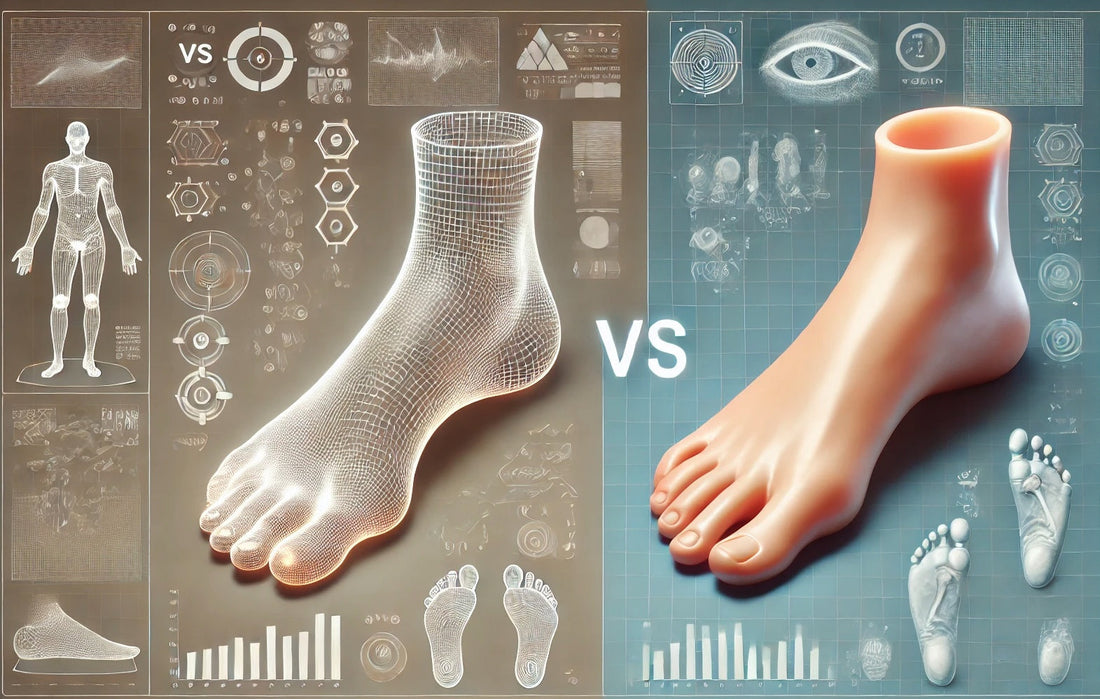
Why Generative AI Can’t Accurately Reconstruct Foot Shape from Images (Yet)
Share
Generative AI (GenAI) and large language models (LLMs) are transforming industries—from content creation to drug discovery. So it’s natural to wonder: Can we use AI to analyze a photo and generate a 3D model of a person’s foot?
It’s a great question, especially for industries like custom insoles, orthotics, and footwear design. Unfortunately, the short answer is:
Not yet. And here’s why.
The Promise: 3D Foot Models from Just a Photo?
Imagine snapping a quick picture of your foot, uploading it to an app, and instantly receiving a perfectly contoured 3D model—or even a pair of custom insoles based on it. That’s the dream.
But in practice, today’s AI—especially LLMs and image-based generative models—falls short for one simple reason:
They don’t understand geometry the way a scanner does.
Why GenAI Struggles with Foot Shape
Here are the main technical limitations:
1. Lack of Depth Information
Images are 2D projections. Without depth data (from a 3D scanner, depth sensor, or multiple calibrated camera angles), it's almost impossible to understand the true contours, arch height, and foot volume.
Even humans can’t accurately judge foot shape from a photo. AI struggles even more.
2. Image-Based Models Aren’t Built for Precision
Generative models like Stable Diffusion or Midjourney are trained to guess what looks right, not to measure physical reality. They can make realistic-looking feet—but realism doesn’t equal accuracy.
When you're making a footbed or orthotic, even a 2mm error can make a big difference in comfort and performance.
3. LLMs Aren’t Image Processors
Large Language Models (like ChatGPT) are great at understanding and generating text—but they don’t directly process 3D data or detailed imagery. Even when combined with image models, they rely on abstract reasoning, not fine-grained measurement.
They can talk about arch types or gait mechanics—but they can’t reconstruct your plantar surface with millimeter precision.
4. AI Models Lack Context (Like Pressure and Motion)
Foot shape isn't just about static structure. It's dynamic. Things like:
- How your foot compresses under weight
- Your gait pattern
- Pressure distribution during walking or running
All of these are invisible in a photo—but they matter deeply when designing insoles or evaluating biomechanics. No GenAI model today can estimate these from a single image.
What Actually Works for Accurate Foot Modeling
To build an accurate 3D foot model, professionals rely on:
- 3D Scanners – Laser, infrared, or structured light-based systems that capture full foot geometry, the method SprinSole custom insoles adopts.
- Pressure Mapping Platforms – Measure plantar pressure under load
- Gait Analysis Systems – Capture motion and load during walking/running
- Foam boxes or Plaster Casting – Tried-and-true methods that still work when digital tools aren’t available
These tools provide real measurements, not guesses. And that’s what’s needed when designing custom-fit solutions.
Final Thoughts
Generative AI is amazing—and it's improving fast. But when it comes to something as personal and precise as foot shape, a single image simply doesn’t provide enough data.
If you're serious about comfort, injury prevention, or athletic performance, your feet deserve better than a guess. For now, stick to real-world foot scanning and measurement technologies—and let GenAI shine where it's strongest: content, communication, and creativity.
